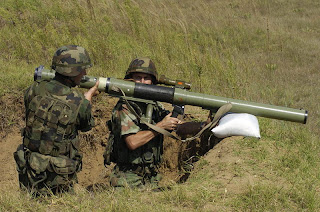Barrett M82 - Special Application Scoped Rifle
Barrett M82 - Special Application Scoped Rifle
The M82 (also more recently known as the M107) is a heavy SASR (Special Application Scoped Rifle) developed by the American Barrett Firearms Company. It is used by many units and armies around the world, including the American Special Forces. It is also called the “Light Fifty” for its .50 caliber BMG (12.7 mm) chambering. The weapon is found in two variants — the original M82A1 (and A3) and the bullpup M82A2. The M82A2 is no longer manufactured, though XM500 can be seen as its successor, in that it also employs a bullpup configuration.
Barrett M82 - Overview
The Barrett Firearms Company was founded by Ronnie Barrett for the single purpose of building semi-automatic rifles chambered for the powerful 12.7×99mm NATO (.50 BMG) ammunition, originally developed for and used in M2 Browning machine guns. Barrett began his work in the early 1980s and the first working rifles were available in 1982, hence the designation M82. Barrett continued to develop his rifle through the 1980s, and developed the improved M82A1 rifle by 1986.
The first conventional military success was the sale of about 100 M82A1 rifles to the Swedish Army in 1989. Major success followed in 1990, when the US Military purchased significant numbers of the M82A1 during operations Desert Shield and Desert Storm in Kuwait and Iraq. About 125 rifles were initially bought by the US Marine Corps, and orders from US Army and Air Force soon followed. The M82A1 is known by the US Military as the SASR — “Special Applications Scoped Rifle”, and it was and still is used as an anti-matériel weapon and EOD (explosive ordnance disposal) tool. The long effective range, over 1500 m with a record shot of 2500 m, along with high energy and availability of highly effective ammunition such as API and Raufoss Mk 211, allows for effective operations against targets like radar cabins, trucks, parked aircraft and so on. The M82 can also be used to defeat human targets from standoff range or when targets are behind cover. However anti-personnel work is not a major application for the M82 (or any other .50 BMG rifle, for that matter). There is a widespread misconception that a number of treaties have banned use of the .50 BMG against human targets, and recruits have been advised by generations of drill instructors to only aim a .50 BMG at an enemy soldier’s web gear or other equipment worn on his body. However, the U.S. Army Judge Advocate General’s office has issued a legal opinion that the .50 BMG and even the Raufoss Mk 211 round are legal for use against enemy personnel.
Further development led to the M82A2 bullpup rifle in 1987, which was a reduced-recoil design to be fired from the shoulder. It failed to make an impression on the world firearms market, and was soon dropped from production. However, in 2006, Barrett had developed the XM500, with a bullpup configuration similar to the M82A2.
The latest derivative of the M82 family is the M82A1M rifle, adopted by USMC as the M82A3 SASR and bought in large numbers. This rifle differs from M82A1 in that it has a full length Picatinny rail that allows a wide variety of scopes and sighting devices to be mounted on the rifle. Other changes are the addition of a rear monopod, slightly lightened mechanism and detachable bipod and muzzle brake.
Another variant of the original weapon is the M82A1A Special Application Scoped Rifle, an almost identical model but specifically designed to fire the Raufoss Mk 211 Mod 0 round, a type of API (Armour Piercing Incendiary) ammunition.
Barrett M82 rifles were bought by various military and police forces from at least 30 countries, such as Belgium, Chile, Denmark, Finland, France, Germany, Greece, Israel, Italy, Jamaica, Indonesia, Mexico, the Netherlands, Norway, the Philippines, Portugal, Saudi Arabia, Spain, Sweden, Turkey, the United Kingdom, the United States and others. The M82 also is widely used for civilian .50 caliber long range shooting competitions, being fired accurately out to 1000 yards (900 m) and even further.
The United States Coast Guard uses the Barrett M82 rifle for drug interdictions. Effective interdiction requires that personnel on Coast Guard cutters be able to deliver accurate fire to stop high-speed drug runners. Similarly, Barrett M82 rifles have attracted attention from law enforcement agencies; they have been adopted by the New York Police Department. If it becomes necessary to immobilize a vehicle, a .50 BMG round in the engine block will shut it down quickly. If it is necessary to breach barriers, a .50 BMG round will penetrate most commercial brick walls and concrete blocks.
According to the documentary The Brooklyn Connection, M82s smuggled into Kosovo by sympathizers in the United States have quickly become popular long range sniper rifles in the Kosovo Liberation Army. In Northern Ireland during the 1990s, the South Armagh Brigade of the Provisional Irish Republican Army (IRA) maintained an extremely effective and intensive sniping campaign against the British Army and the Royal Ulster Constabulary police. The Barrett rifle was used, and in 1997 it was used to kill the last British soldier to die in the conflict, Stephen Restorick. Later, a top IRA sniper, Michael Caraher, was arrested and his Barrett rifle was captured by British forces. Caraher caused the death of 7 British soldiers and 2 police officers.
As a side note, the Barrett M82A1 rifle was used in 2002 as a platform for the experimental OSW (Objective Sniper Weapon) prototype. This weapon was fitted with a shorter barrel of 25 mm caliber, and fired high explosive shells developed for the 25 x 59 mm OCSW automatic grenade launcher. The experimental OSW showed an increased effectiveness against various targets, but the recoil was beyond human limitations. This weapon, also known as the Barrett ‘Payload Rifle’, has now been designated the XM109.

Comments